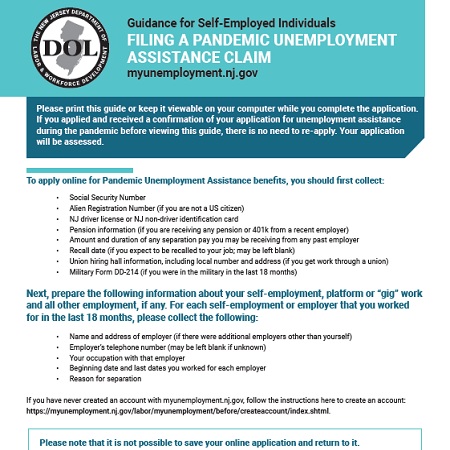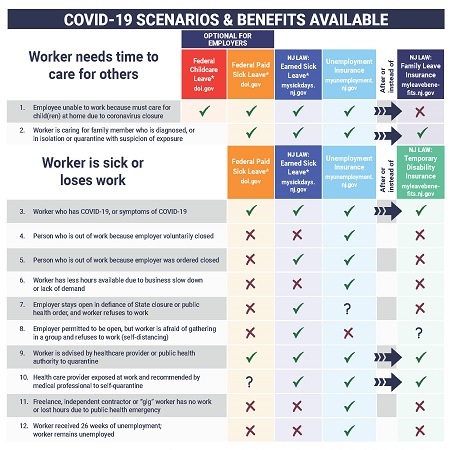Pandemic Unemployment Assistance (PUA): Expanded Unemployment Eligibility During the Coronavirus Emergency

Pandemic Unemployment Assistance (PUA) provides benefits for NJ workers who are:
- not eligible for unemployment benefits in any state, including self-employed workers (independent workers, “gig” workers)
- otherwise able and available to work except that they are unemployed, partially unemployed, or unable or unavailable to work due to a COVID-19 qualifying reason, and
- able to demonstrate labor market attachment, through earnings or an official work offer.
To be eligible for PUA, you must meet the three following qualifications:
1. You must not be eligible for unemployment benefits in any state, including self-employed workers (independent workers, “gig” workers)
- Your claim is invalid due to self-employment, your employer is exempt (for example, a church), or you have insufficient work history.
- You’re ineligible because you had a prior disqualification or couldn’t meet a requirement. For example, you didn’t earn enough.
- You exhausted all benefit entitlement under regular unemployment.
Please note: If you believe you’re eligible for regular unemployment, learn more about eligibility here.
2. You must be otherwise able and available to work except that you are unemployed, partially unemployed, or unable or unavailable to work due to a COVID-19 qualifying reason (listed below as a, b, c and d):
-
You are sick, quarantined, or exposed:
- You were diagnosed with COVID-19 or are experiencing symptoms and seeking medical diagnosis
- You were advised by a medical provider to self-quarantine due to COVID-19
- A member of your household was diagnosed with COVID–19
-
You need care for a family member or household member:
- You are providing care for a family member or a member of your household who has been diagnosed with COVID-19
- You are the primary caregiver for a child or family member who is unable to attend school or another facility which is closed due to COVID-19
- You became the breadwinner because the head of household has died from COVID-19
-
You lost employment:
- Your place of employment is closed due to the COVID-19 public health emergency
- You are an employee and your hours have been reduced or you were laid off as a direct result of the COVID-19 public health emergency
- You quit your job because you were diagnosed with COVID-19 and continuing work is not possible, or because you came into contact with an individual who was diagnosed with COVID-19 and a medical professional advised that you resign in order to quarantine
- You are unable to reach your place of employment due to an imposed quarantine or you were scheduled to commence employment and do not have a job or are unable to reach the job due to COVID-19
- You are self-employed / an independent contractor / a 1099 filer / a farmer and you’re experiencing a significant reduction of services because of the COVID-19 public health emergency
- You provide services to an educational institution or educational service agency and are unemployed or partially unemployed because of volatility in the work schedule due to the COVID-19 public health emergency. This includes, but is not limited to, changes in schedules and partial closures.
-
You have health and safety concerns:
- You were denied continued unemployment benefits because you refused to return to work or accept an offer of work at a worksite that is not in compliance with local, state, or national health and safety standards directly related to COVID-19. This includes but is not limited to, those related to facial mask wearing, physical distancing measures, or the provision of personal protective equipment consistent with public health guidelines.
3. You must be able to demonstrate labor market attachment with either:
- wage history (covered employment, self-employment, exempt employment) in 2019/2020, prior to the point you were impacted by the pandemic; or
- a bona fide offer of work that was to begin during the pandemic, but could not due to the pandemic (a bona fide offer means a definite, official offer with a start date, not just an interview or potential employment)
PUA calculates your benefit level based on the income you received in the last completed tax year before you filed your claim. For example, if you filed a claim in 2020, then your 2019 income will be used to calculate your benefit level. If you are self-employed, your NET income (after deductions) is used to calculate your benefit level. If you are not self-employed, your GROSS income (before deductions) is used to calculate your benefit level. The calculation to determine the amount payable is the same as regular unemployment (60% of your average weekly salary, up to a maximum of $731 per week) for up to a total of 75 weeks. PUA benefits are subject to federal income taxes.
If you do not meet the monetary requirements for a valid unemployment claim, you will receive the PUA minimum, $230 per week.
PUA recipients may also be eligible for an extra $300 per week from January 2021 to the week ending September 4, 2021 through Federal Pandemic Unemployment Compensation (FPUC), which is also taxable.
The American Rescue Plan Act, signed March 11, 2021, extended the maximum number of weeks from 50 weeks to 75 weeks. PUA benefits available through the American Rescue Plan Act currently expire September 4, 2021.
An outline of the steps to apply for benefits can be found here. Self-employed workers should refer to our PUA application guide, which has helpful hints and information to aide you in the process.
Per federal rules, the first step to access these expanded benefits is to be found ineligible for traditional unemployment benefits, which means you need to apply and be denied. You always have the right to file an appeal for a denial, but that can be a lengthy process, and NJDOL will contact you regarding next steps and to gather additional information necessary to assess you for PUA.
To receive PUA benefits on or after December 27, 2020 you will have to provide documentation that you had employment, or that you planned to begin employment but could not due to the coronavirus. Learn more under our question below, “How do I upload documentation verifying proof of income prior to the pandemic?”
The PUA benefits can be paid retroactively for periods of unemployment, beginning on or after February 2, 2020, and are currently set to end September 4, 2021. If you believe your claim should be backdated, you’ll need to inform us by contacting our call center, even if you submit your application online. We will then schedule a fact-finding interview to determine if your claim can be backdated.
If you received a confirmation number, you do not have to take any action - your claim will be reviewed by Unemployment Insurance staff. Our system is experiencing record levels of demand and all in-person services statewide are currently only available virtually due to COVID-19. If you believe your claim should be backdated, you’ll need to inform us by contacting our call center, even if you submit your application online. We will then schedule a fact-finding interview to determine if your claim can be backdated.
Per the Continued Assistance Act, signed December 27, 2020, claimants receiving PUA now must demonstrate that they were working or about to commence employment/self-employment, by providing documentation about earnings or an official work offer.
If you began collecting PUA benefits prior to December 27, 2020, for weeks of benefits between December 27, 2020 through the end of the PUA program, you will have 90 days to submit documentation.
If you file a new PUA claim after January 31, 2021, you will have 21 days to submit documentation.
The following documents are acceptable proof of income prior to the pandemic. Please note that you only need to upload ONE of these documents, but you may upload as many as you think will be helpful for determining your earnings or official work offer. Please use a standard file format such as PDF, JPG, JPEG, DOC or DOCX. Do not send attachments with the .HEIC extension, as these files cannot be viewed and will not count as proof of employment. Please convert .HEIC files to an accepted file, such as a PDF or a JPG.
Covered Employment
- Paycheck stubs
- Earnings and leave statements that include the employer's name and address
- W-2
Self-Employment
- 2019 or 2020 tax returns with appropriate attachments (Schedule C, Schedule C-EZ, Schedule F, 1065 with K-1 attachment, Schedule SE)
- Invoices with your name or your company name, including payment for that invoice
- Registration of a company with the state or federal employer identification number
- Business license
- 1099s
Commencement of Employment
- Offer letter of employment
- Statement/signed affidavit by an individual stating details of work offered (this must include the individual’s name, address, and contact number for verification)
Commencement of Self-Employment
- Business license
- State or Federal Employer Identification Number
- Written business plan
- Lease agreement
First, gather documentation to prove earnings or an official work offer. View the question above for a list of acceptable documentation.
Step 1: You will receive an email from e-Adjudication. This email will ask you to click on a link titled “Claimant Form,” which will direct you to NJDOL’s secure sign in. Enter your email address and password.
- If you do not receive this email, please be sure to check your spam folder.
- To access the form, you need your email address and password. Emails asking to respond with additional information, like your social security number, may be spam.
You will be directed to the Welcome page. Read the instructions on how to save this form and select next.
Step 2: You will be directed to the PUA Verification page and asked to answer the following required questions.
- Did you work in self-employment in 2019 or 2020? (this means you were not paid with a form W2; you may have been paid with a form 1099)
- Did you work in covered employment in 2019 or 2020? (this means you are paid by a form W2)
- Were you scheduled to commence employment during the pandemic that could not begin as scheduled?
You will be asked when you began working for each employer (or when was your scheduled start date), and when was your last day you worked prior to the pandemic.
Step 3: You will be directed to the Document Upload page. Upload your document(s) verifying proof of income or an official work offer.
- You only need to upload ONE of these documents, but you may upload as many as you think will be helpful for determining your earnings or official work offer.
- Please use a standard file format such as PDF, JPG, JPEG, DOC or DOCX.
- Do not send attachments with the .HEIC extension, these files cannot be viewed and will not count as proof of employment. Please convert .HEIC files to an accepted file, such as a PDF or a JPG.
- You may take and upload a picture of these documents if it is an accepted file format. Please ensure that the picture is not blurry, that it captures the entire document, and that the document is readable.
- Make sure to hit “upload” document after selecting your file. If you do not click upload, you will not have attached the required documentation.
Step 4: You will be directed to the Certify & Submit page. It should confirm that you have at least one document attached. If this page says you have submitted zero documents, you did not successfully attach your proof of income. Return to the prior screen and be sure to select “upload” under your attached document.
Please note: We cannot verify your claim if you do not successfully attach your proof of income earned prior to the pandemic. Without this verification, you will be denied benefits and have to pay back any benefits you’ve received on this claim since December 27, 2020. Please make sure your documents are submitted.
After, check the box certifying that your answers are true and accurate, and select submit.
You must certify weekly. Review these guidelines when certifying your weekly benefits to ensure you receive your benefits without delay.
PUA calculates your benefit level based on income you received in the last completed tax year before you filed your claim. For example, if you filed a claim in 2020, then your 2019 income will be used to calculate your benefit level. If you are self-employed, your NET income (after deductions) is used to calculate your benefit level. If you are not self-employed, your GROSS income (before deductions) is used to calculate your benefit level. The calculation to determine the amount payable is the same as regular unemployment (60% of your average weekly salary, up to a maximum of $731 per week) for up to a total of 75 weeks. PUA benefits are subject to federal income taxes.
If you do not meet the monetary requirements for a valid unemployment claim, you will receive the PUA minimum, $230 per week.
PUA recipients may also be eligible for an extra $300 per week from January 2021 to the week ending September 4, 2021 through Federal Pandemic Unemployment Compensation (FPUC), which is also taxable.
Please refer to our guidance for self-employed individuals filing a pandemic unemployment assistance claim and follow the steps outlined here to apply.
Per federal rules, the first step to access these expanded benefits is to be found ineligible for traditional unemployment benefits, which means you need to apply and be denied. You always have the right to file an appeal for a denial, but that can be a lengthy process, and NJDOL will contact you regarding next steps and to gather any additional information necessary to assess you for PUA.
To receive PUA benefits on or after December 27, 2020 you will have to provide documentation that you had self-employment, or that you planned to begin self-employment but could not due to the coronavirus. Learn more under our question in the previous tab, “How do I verify proof of income prior to the pandemic?”
The PUA benefits can be paid retroactively for periods of unemployment, beginning on or after February 2, 2020, and are currently set to end September 4, 2021. If you believe your claim should be backdated, you’ll need to inform us by contacting our call center, even if you submit your application online. We will then schedule a fact-finding interview to determine if your claim can be backdated.
The federal Families First Coronavirus Response Act (FFCRA) took effect April 1, 2020 and gave certain workers access to emergency paid leave to care for themselves or a loved one, or to care for their children at home, due to coronavirus, and provided tax credits for these leaves to employers and self-employed workers. The federal American Rescue Plan Act, signed March 11, 2021, extended the tax credits through September 30, 2021. This is a federal program; NJDOL is providing this information as a resource to our workers. Questions should be directed to the USDOL and IRS.
For additional guidance, visit:
- USDOL: Families First Coronavirus Response Act: Questions and Answers
- IRS: COVID-19-Related Tax Credits for Paid Leave Provided by Small and Midsize Businesses FAQs
- IRS: Specific Provisions Related to Self-Employed Individuals
To receive these benefits, it is recommended that you keep the following records:
- Documentation to show how you determined the amount of sick leave and childcare leave that you used, including records of work and telework;
- Documentation to show how you determined these expenses;
- Copies of any completed IRS Forms 7200 (“Advance Payment of Employer Credits Due to COVID-19”) that you submitted to the IRS;
- Copies of the completed IRS Forms 941 (“Employer’s Quarterly Federal Tax Return”) you submitted to the IRS; and,
- Any other relevant documents requested by the IRS. For more information, please consult IRS: COVID-19-Related Tax Credits for Paid Leave Provided by Small and Midsize Businesses FAQs
 Official Site of The State of New Jersey
Official Site of The State of New Jersey

